Lenovo MT 0022, MT 0611, T410si, MT 3507, MT 2876 Service Manual
...
Hardware Maintenance Manual
ThinkPad X100e and X120e
Note
Before using this information and the product it supports, be sure to read the general information under Appendix A “Notices” on page 123.
Seventh Edition (March 2012)
© Copyright Lenovo 2011, 2012.
LIMITED AND RESTRICTED RIGHTS NOTICE: If data or software is delivered pursuant a General Services Administration “GSA” contract, use, reproduction, or disclosure is subject to restrictions set forth in Contract No. GS-35F-05925.

Contents
About this manual. . . . . . . . . . . iii
Chapter 1. Safety information . . . . . . 1
General safety . . . . . . . . . . . . . . . . 1 Electrical safety . . . . . . . . . . . . . . . 2 Safety inspection guide . . . . . . . . . . . . 3
Handling devices that are sensitive to electrostatic discharge. . . . . . . . . . . . . . . . . . 3
Grounding requirements . . . . . . . . . . . . 4 Safety notices - multilingual translations. . . . . . 4
Chapter 2. Important service |
|
information . . . . . . . . . . . . . . |
19 |
Strategy for replacing FRUs . . . . . . . . . |
19 |
Strategy for replacing a hard disk drive . . . |
20 |
Important notice for replacing a system |
|
board . . . . . . . . . . . . . . . . |
20 |
How to use error codes . . . . . . . . . |
20 |
Strategy for replacing FRUs for CTO, CMV, and |
|
GAV . . . . . . . . . . . . . . . . . . . |
20 |
Product definition. . . . . . . . . . . . |
20 |
FRU identification for CTO, CMV, and GAV |
|
products . . . . . . . . . . . . . . . |
21 |
Chapter 3. General checkout . . . . . |
23 |
What to do first . . . . . . . . . . . . . . |
23 |
Checkout guide . . . . . . . . . . . . . . |
24 |
System supporting the Lenovo ThinkVantage |
|
Toolbox program and the PC-Doctor for DOS |
|
diagnostics program . . . . . . . . . . |
24 |
System supporting the Lenovo diagnostics |
|
programs . . . . . . . . . . . . . . . |
29 |
Power system checkout . . . . . . . . . . . |
31 |
Checking the ac power adapter . . . . . . |
31 |
Checking operational charging . . . . . . |
32 |
Checking the battery pack . . . . . . . . |
32 |
Checking the backup battery . . . . . . . |
33 |
Chapter 4. Related service |
|
information . . . . . . . . . . . . . . |
35 |
Restoring the factory contents by using Recovery |
|
Disc Set . . . . . . . . . . . . . . . . . |
35 |
Passwords . . . . . . . . . . . . . . . . |
36 |
Power-on password . . . . . . . . . . . |
36 |
Hard-disk password. . . . . . . . . . . |
36 |
Supervisor password . . . . . . . . . . |
37 |
How to remove the power-on password . . . |
37 |
How to remove the hard-disk password . . . |
37 |
Power management . . . . . . . . . . . . |
38 |
Screen blank mode . . . . . . . . . . . |
38 |
Sleep or standby mode . . . . . . . . . |
38 |
Hibernation mode . . . . . . . . . . . |
39 |
Symptom-to-FRU index . . . . . . . . . . . |
39 |
Numeric error codes . . . . . . . . . . |
40 |
Error messages . . . . . . . . . . . . |
42 |
No-beep symptoms . . . . . . . . . . . |
42 |
LCD-related symptoms . . . . . . . . . |
42 |
Intermittent problems . . . . . . . . . . |
43 |
Undetermined problems . . . . . . . . . |
43 |
Chapter 5. Status indicators . . . . . |
45 |
|
Chapter 6. Fn key combinations . . . |
47 |
|
Chapter 7. FRU replacement |
|
|
notices . . . . . . . . . . . . . . . . |
49 |
|
Screw notices . . . . . . . . . . . . . . . |
49 |
|
Retaining serial numbers. . . . . . . . . . . |
50 |
|
Restoring the serial number of the system |
|
|
unit . . . . . . . . . . . . . . . . . |
50 |
|
Retaining the UUID . . . . . . . . . . . |
51 |
|
Reading or writing the ECA information . . . |
51 |
|
Chapter 8. Removing and replacing a |
|
|
FRU . . . . . . . . . . . . . . . . . . |
53 |
|
Before servicing ThinkPad X100e and ThinkPad |
|
|
X120e . . . . . . . . . . . . . . . . . . |
53 |
|
1010 |
Battery pack . . . . . . . . . . . . . |
54 |
1020 |
Bottom door . . . . . . . . . . . . . |
55 |
1030 |
Hard disk drive (HDD). . . . . . . . . . |
58 |
1040 |
DIMM . . . . . . . . . . . . . . . . |
60 |
1050 |
PCI Express Mini Card for wireless LAN . . |
60 |
1060 |
PCI Express Mini Card for wireless WAN . . |
61 |
1070 |
Bluetooth daughter card (BDC-2) . . . . . |
62 |
1080 |
Keyboard . . . . . . . . . . . . . . |
64 |
1090 Palm rest assembly, power-on board |
|
|
assembly (with cable), and microphone . . . . . |
67 |
|
1100 |
CRT board assembly (with cable) . . . . . |
71 |
1110 |
Speaker assembly . . . . . . . . . . . |
72 |
1120 |
I/O board (for ThinkPad X120e) . . . . . . |
73 |
1130 System board, fan assembly, and backup |
|
|
battery . . . . . . . . . . . . . . . . . . |
74 |
|
1140 |
LCD unit . . . . . . . . . . . . . . . |
80 |
1150 |
DC-in cable and base cover assembly . . . |
82 |
2010 |
LCD bezel assembly . . . . . . . . . . |
84 |
2020 |
Integrated camera . . . . . . . . . . . |
85 |
2030 |
LCD panel, hinges, and LCD cable . . . . |
86 |
© Copyright Lenovo 2011, 2012 |
i |
2090 Antenna kit and LCD rear cover assembly. . 88
Chapter 9. Locations . . . . . . . . . |
91 |
Front view . . . . . . . . . . . . . . . . |
91 |
Rear view. . . . . . . . . . . . . . . . . |
92 |
Bottom view . . . . . . . . . . . . . . . |
92 |
Chapter 10. Parts list . . . . . . . . . |
93 |
Overall . . . . . . . . . . . . . . . . . . |
94 |
LCD FRUs . . . . . . . . . . . . . . . . |
108 |
Keyboard . . . . . . . . . . . . . . . . . |
111 |
AC adapters . . . . . . . . . . . . . . . |
112 |
Miscellaneous parts . . . . . . . . . . . . |
112 |
Power cords . . . . . . . . . . . . . . . |
113 |
Recovery discs . . . . . . . . . . . . . . |
114 |
Windows 7 Starter (32 bit) DVDs . . . . . . |
114 |
|
Windows 7 Home Basic (32 bit) DVDs. . . . |
115 |
|
Windows 7 Home Premium (32 bit) DVDs . . |
116 |
|
Windows 7 Home Premium (64 bit) DVDs . . |
117 |
|
Windows 7 |
Professional (32 bit) DVDs. . . . |
118 |
Windows 7 |
Professional (64 bit) DVDs. . . . |
119 |
Windows 7 |
Ultimate (32 bit) DVDs . . . . . |
120 |
Windows 7 |
Ultimate (64 bit) DVDs . . . . . |
120 |
Windows Vista Business (32 bit) DVDs . . . |
121 |
|
Windows Vista Home Basic (32 bit) DVDs . . |
121 |
|
Common service tools . . . . . . . . . . . |
121 |
|
Appendix A. Notices. . . . . . . . . |
123 |
Trademarks . . . . . . . . . . . . . . . . |
124 |
ii Hardware Maintenance Manual

About this manual
This manual contains service and reference information for the following ThinkPad® products:
ThinkPad X100e
MT 0022, 2876, 3506, 3507, and 3508
ThinkPad X120e
MT 0596, 0611, and 0613
Use this manual along with the advanced diagnostic tests to troubleshoot problems.
Important: This manual is intended only for trained service technicians who are familiar with ThinkPad products. Use this manual along with the advanced diagnostic tests to troubleshoot problems effectively. Before servicing a ThinkPad product, be sure to read all the information under Chapter 1 “Safety information” on page 1.
© Copyright Lenovo 2011, 2012 |
iii |
iv Hardware Maintenance Manual

Chapter 1. Safety information
This chapter presents following safety information that you need to be familiar with before you service a ThinkPad Notebook.
•“General safety” on page 1
•“Electrical safety” on page 2
•“Safety inspection guide” on page 3
•“Handling devices that are sensitive to electrostatic discharge” on page 3
•“Grounding requirements” on page 4
•“Safety notices - multilingual translations” on page 4
General safety
Follow these rules to ensure general safety:
•Observe good housekeeping in the area of the machines during and after maintenance.
•When lifting any heavy object:
1.Make sure that you can stand safely without slipping.
2.Distribute the weight of the object equally between your feet.
3.Use a slow lifting force. Never move suddenly or twist when you attempt to lift.
4.Lift by standing or by pushing up with your leg muscles; this action removes the strain from the muscles in your back. Do not attempt to lift any object that weighs more than 16 kg (35 lb) or that you think is too heavy for you.
•Do not perform any action that causes hazards to the customer, or that makes the equipment unsafe.
•Before you start on the machine, make sure that other service technicians and the customer's personnel are not in a hazardous position.
•Place removed covers and other parts in a safe place, away from all personnel, while you are servicing the machine.
•Keep your toolcase away from walk areas so that other people will not trip over it.
•Do not wear loose clothing that can be trapped in the moving parts of a machine. Make sure that your sleeves are fastened or rolled up above your elbows. If your hair is long, fasten it.
•Insert the ends of your necktie or scarf inside clothing or fasten it with a nonconductive clip, about 8 centimeters (3 inches) from the end.
•Do not wear jewelry, chains, metal-frame eyeglasses, or metal fasteners for your clothing.
Attention: Metal objects are good electrical conductors.
•Wear safety glasses when you are hammering, drilling, soldering, cutting wire, attaching springs, using solvents, or working in any other conditions that might be hazardous to your eyes.
•After service, reinstall all safety shields, guards, labels, and ground wires. Replace any safety device that is worn or defective.
•Reinstall all covers correctly before returning the machine to the customer.
•Fan louvers on the machine help to prevent overheating of internal components. Do not obstruct fan louvers or cover them with labels or stickers.
© Copyright Lenovo 2011, 2012 |
1 |

Electrical safety
Observe the following rules when working on electrical equipment.
Important:
Use only approved tools and test equipment. Some hand tools have handles covered with a soft material that does not insulate you when working with live electrical currents.
Many customers have, near their equipment, rubber floor mats that contain small conductive fibers to decrease electrostatic discharges. Do not use this type of mat to protect yourself from electrical shock.
•Find the room emergency power-off (EPO) switch, disconnecting switch, or electrical outlet. If an electrical accident occurs, you can then operate the switch or unplug the power cord quickly.
•Do not work alone under hazardous conditions or near equipment that has hazardous voltages.
•Disconnect all power before:
–Performing a mechanical inspection
–Working near power supplies
–Removing or installing main units
•Before you start to work on the machine, unplug the power cord. If you cannot unplug it, ask the customer to power-off the wall box that supplies power to the machine, and to lock the wall box in the off position.
•If you need to work on a machine that has exposed electrical circuits, observe the following precautions:
–Ensure that another person, familiar with the power-off controls, is near you.
Attention: Another person must be there to switch off the power, if necessary.
–Use only one hand when working with powered-on electrical equipment; keep the other hand in your pocket or behind your back.
Attention: An electrical shock can occur only when there is a complete circuit. By observing the above rule, you may prevent a current from passing through your body.
–When using testers, set the controls correctly and use the approved probe leads and accessories for that tester.
–Stand on suitable rubber mats (obtained locally, if necessary) to insulate you from grounds such as metal floor strips and machine frames.
Observe the special safety precautions when you work with very high voltages; Instructions for these precautions are in the safety sections of maintenance information. Use extreme care when measuring high voltages.
•Regularly inspect and maintain your electrical hand tools for safe operational condition.
•Do not use worn or broken tools and testers.
•Never assume that power has been disconnected from a circuit. First, check that it has been powered off.
•Always look carefully for possible hazards in your work area. Examples of these hazards are moist floors, nongrounded power extension cables, power surges, and missing safety grounds.
•Do not touch live electrical circuits with the reflective surface of a plastic dental mirror. The surface is conductive; such touching can cause personal injury and machine damage.
•Do not service the following parts with the power on when they are removed from their normal operating places in a machine:
–Power supply units
–Pumps
–Blowers and fans
–Motor generators
–Similar units to listed above
This practice ensures correct grounding of the units.
• If an electrical accident occurs:
2 Hardware Maintenance Manual

–Use caution; do not become a victim yourself.
–Switch off power.
–Send another person to get medical aid.
Safety inspection guide
The purpose of this inspection guide is to assist you in identifying potentially unsafe conditions. As each machine was designed and built, required safety items were installed to protect users and service technicians from injury. This guide addresses only those items. You should use good judgment to identify potential safety hazards due to attachment of non-ThinkPad features or options not covered by this inspection guide.
If any unsafe conditions are present, you must determine how serious the apparent hazard could be and whether you can continue without first correcting the problem.
Consider these conditions and the safety hazards they present:
•Electrical hazards, especially primary power (primary voltage on the frame can cause serious or fatal electrical shock)
•Explosive hazards, such as a damaged CRT face or a bulging capacitor
•Mechanical hazards, such as loose or missing hardware
To determine whether there are any potentially unsafe conditions, use the following checklist at the beginning of every service task. Begin the checks with the power off, and the power cord disconnected.
Checklist:
1.Check exterior covers for damage (loose, broken, or sharp edges).
2.Power off the computer. Disconnect the power cord.
3.Check the power cord for:
a.A third-wire ground connector in good condition. Use a meter to measure third-wire ground continuity for 0.1 ohm or less between the external ground pin and the frame ground.
b.The power cord should be the type specified in the parts list.
c.Insulation must not be frayed or worn.
4.Check for cracked or bulging batteries.
5.Remove the cover.
6.Check for any obvious non-ThinkPad alterations. Use good judgment as to the safety of any non-ThinkPad alterations.
7.Check inside the unit for any obvious unsafe conditions, such as metal filings, contamination, water or other liquids, or signs of fire or smoke damage.
8.Check for worn, frayed, or pinched cables.
9.Check that the power-supply cover fasteners (screws or rivets) have not been removed or tampered with.
Handling devices that are sensitive to electrostatic discharge
Any computer part containing transistors or integrated circuits (ICs) should be considered sensitive to electrostatic discharge (ESD.) ESD damage can occur when there is a difference in charge between objects. Protect against ESD damage by equalizing the charge so that the machine, the part, the work mat, and the person handling the part are all at the same charge.
Note:
Use product-specific ESD procedures when they exceed the requirements noted here.
Chapter 1. Safety information 3
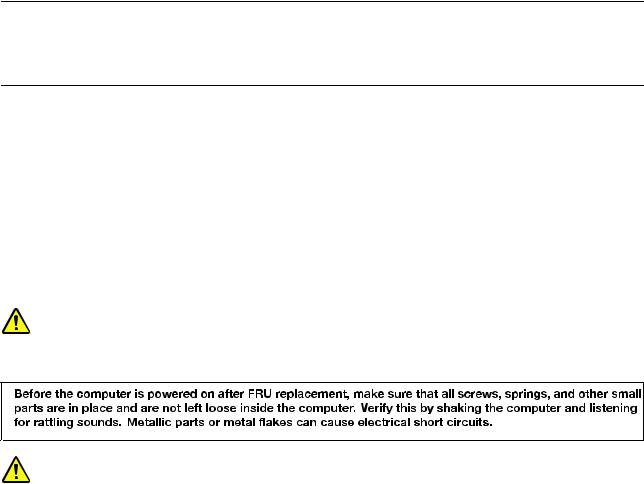
Make sure that the ESD protective devices you use have been certified (ISO 9000) as fully effective.
When handling ESD-sensitive parts:
•Keep the parts in protective packages until they are inserted into the product.
•Avoid contact with other people.
•Wear a grounded wrist strap against your skin to eliminate static on your body.
•Prevent the part from touching your clothing. Most clothing is insulative and retains a charge even when you are wearing a wrist strap.
•Use a grounded work mat to provide a static-free work surface. The mat is especially useful when handling ESD-sensitive devices.
•Select a grounding system, such as those listed below, to provide protection that meets the specific service requirement.
Note: The use of a grounding system to guard against ESD damage is desirable but not necessary.
–Attach the ESD ground clip to any frame ground, ground braid, or green-wire ground.
–When working on a double-insulated or battery-operated system, use an ESD common ground or reference point. You can use coax or connector-outside shells on these systems.
–Use the round ground prong of the ac plug on ac-operated computers.
Grounding requirements
Electrical grounding of the computer is required for operator safety and correct system function. Proper grounding of the electrical outlet can be verified by a certified electrician.
Safety notices - multilingual translations
The safety notices in this section are provided in the following languages:
•English
•Arabic
•Brazilian Portuguese
•French
•German
•Hebrew
•Japanese
•Korean
•Spanish
•Traditional Chinese
DANGER
DANGER
4 Hardware Maintenance Manual

DANGER
DANGER
DANGER
DANGER
DANGER
Chapter 1. Safety information 5
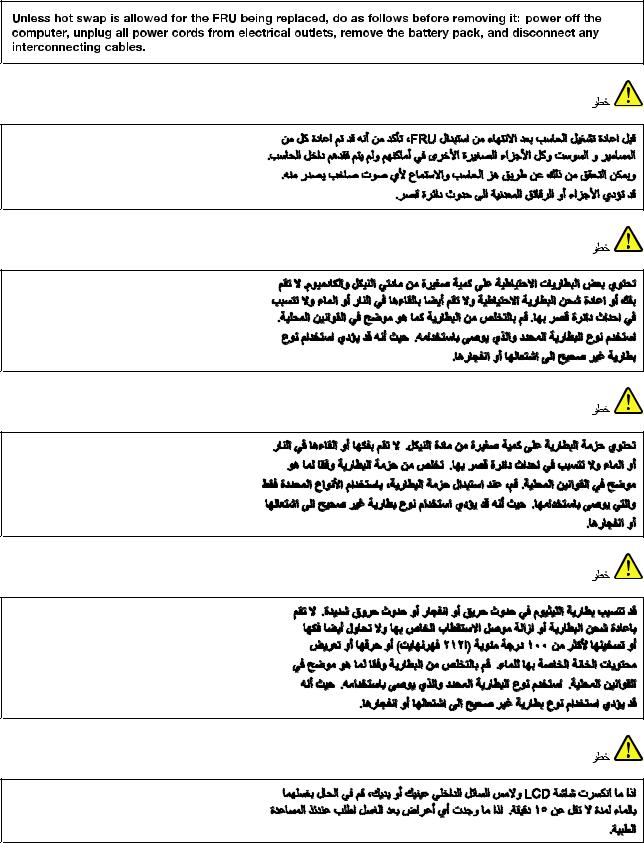
DANGER
6 Hardware Maintenance Manual

PERIGO
PERIGO
PERIGO
Chapter 1. Safety information 7
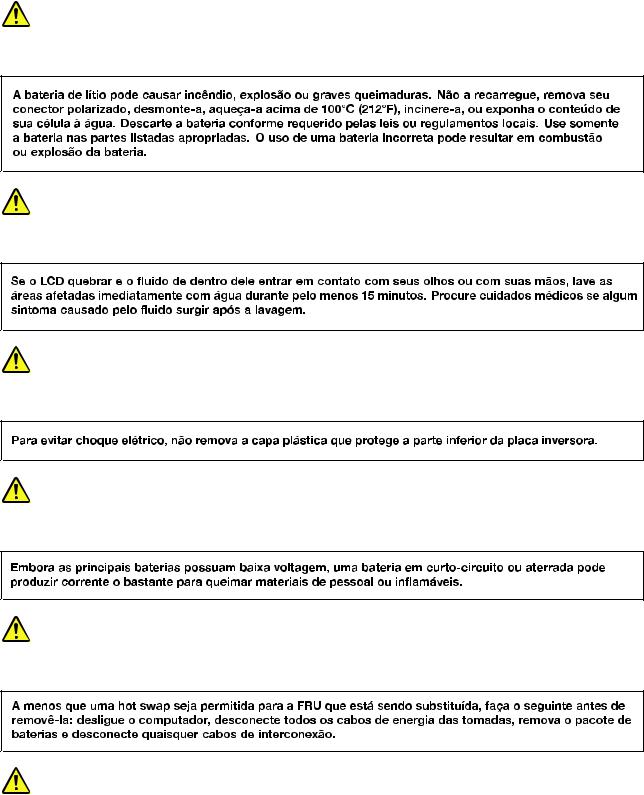
PERIGO
PERIGO
PERIGO
PERIGO
PERIGO
DANGER
8 Hardware Maintenance Manual
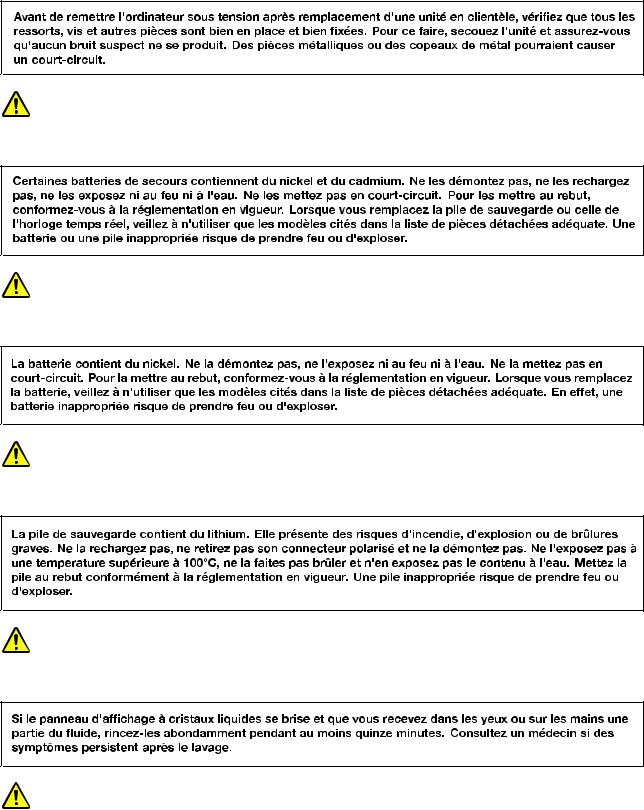
DANGER
DANGER
DANGER
DANGER
DANGER
Chapter 1. Safety information 9

DANGER
DANGER
VORSICHT
VORSICHT
VORSICHT
10 Hardware Maintenance Manual
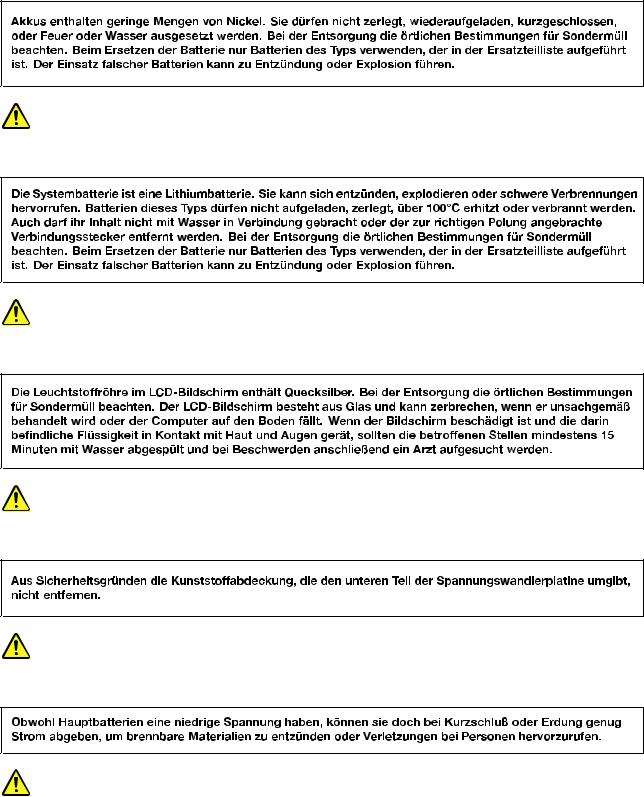
VORSICHT
VORSICHT
VORSICHT
VORSICHT
VORSICHT
Chapter 1. Safety information 11
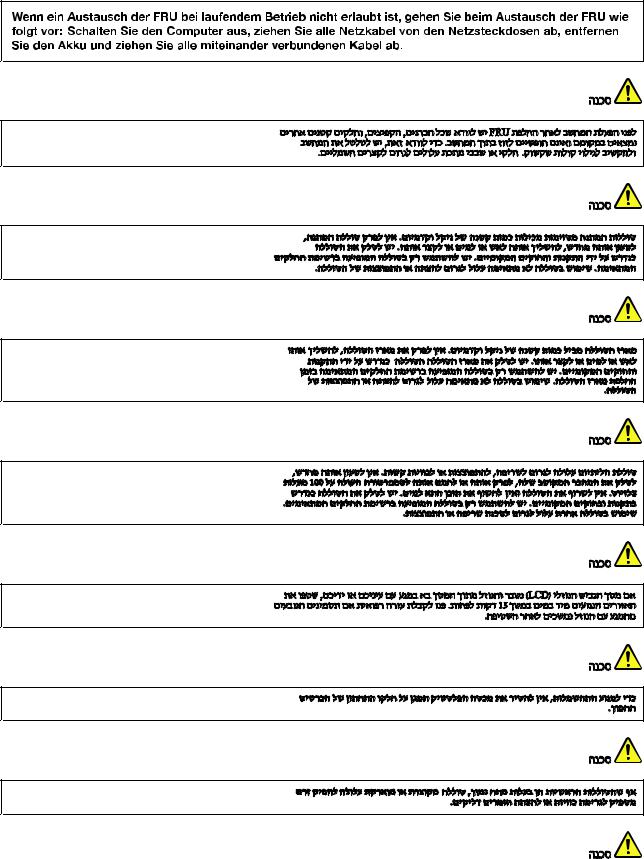
12 Hardware Maintenance Manual
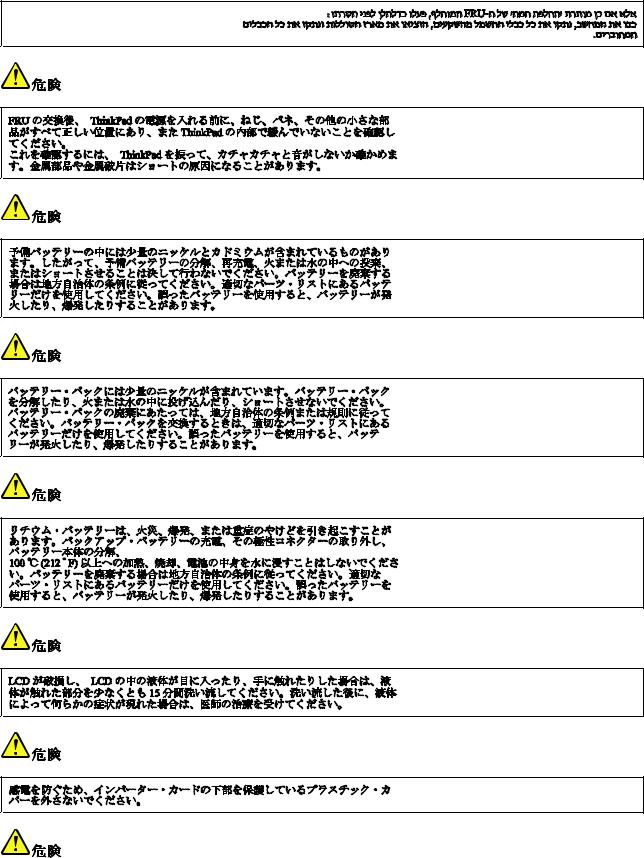
Chapter 1. Safety information 13
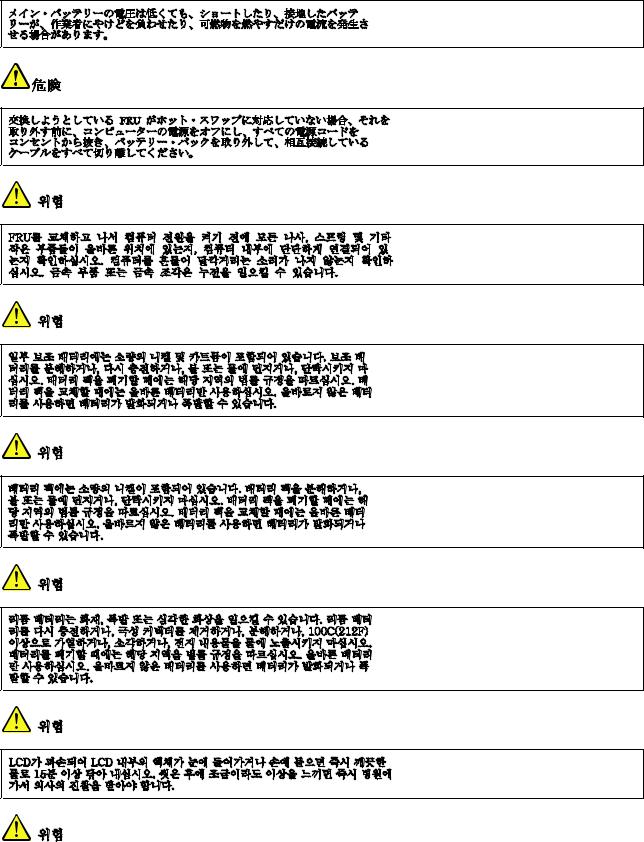
14 Hardware Maintenance Manual
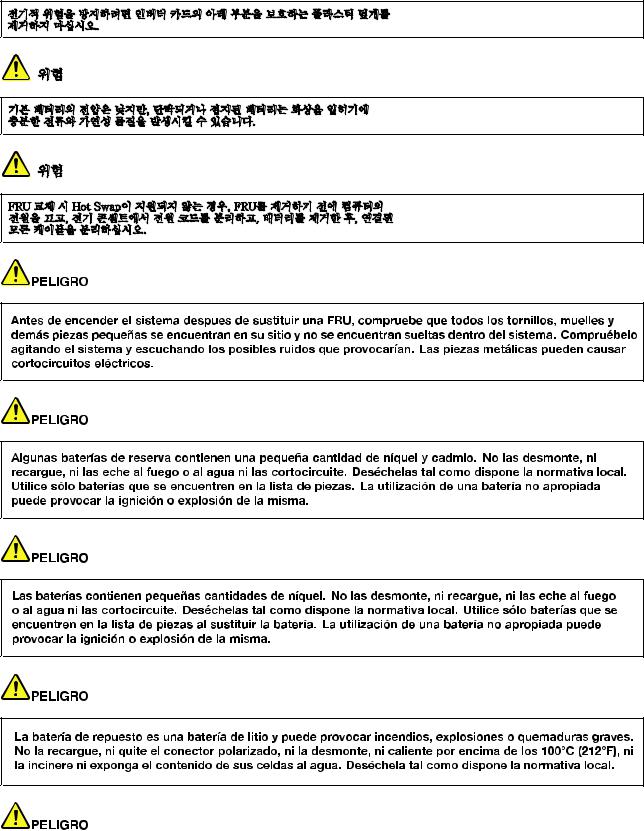
Chapter 1. Safety information 15
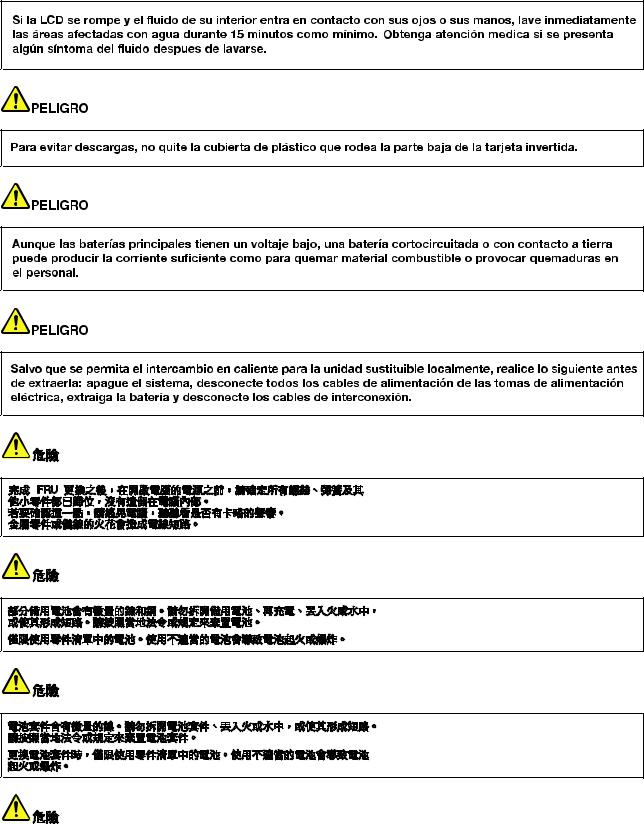
16 Hardware Maintenance Manual
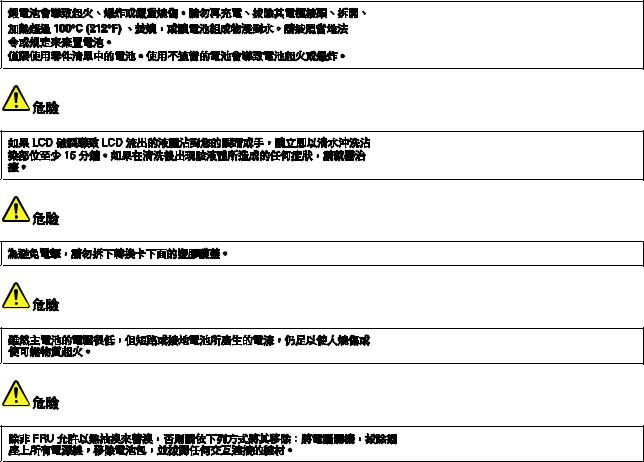
Chapter 1. Safety information 17
18 Hardware Maintenance Manual

Chapter 2. Important service information
This chapter presents following important service information that applies to all machine types supported by this manual:
•“Strategy for replacing FRUs” on page 19
–“Strategy for replacing a hard disk drive” on page 20
–“Important notice for replacing a system board” on page 20
–“How to use error codes” on page 20
•“Strategy for replacing FRUs for CTO, CMV, and GAV” on page 20
–“Product definition” on page 20
–“FRU identification for CTO, CMV, and GAV products” on page 21
Important:
•Advise customers to contact the Lenovo Customer Support Center if they need any assistance in obtaining or installing any software fixes, drivers, and BIOS downloads. Telephone numbers for Lenovo Support are available at:
http://www.lenovo.com/support/phone
•System disassembly and reassembly videos that show the FRU removal or replacement procedures for the Lenovo® authorized service technicians are available at:
http://www.lenovoservicetraining.com/ion/
Strategy for replacing FRUs
Before replacing parts:
Make sure that all software fixes, drivers, and BIOS downloads are installed before replacing any FRUs listed in this manual.
After a system board is replaced, ensure that the latest BIOS is loaded to the system board before completing the service action.
To download software fixes, drivers, and BIOS, do as follows:
1.Go to http://www.lenovo.com/support.
2.Click Download Drivers & Software and then follow the instructions on the screen to reach the Download Drivers and Software page.
3.Follow the instructions on the screen to download and install the necessary software.
Use the following strategies to prevent unnecessary expense for replacing and servicing FRUs:
•If you are instructed to replace a FRU but the replacement does not correct the problem, reinstall the original FRU before you continue.
•Some computers have both a processor board and a system board. If you are instructed to replace either the processor board or the system board, and replacing one of them does not correct the problem, reinstall that board, and then replace the other one.
•If an adapter or a device consists of more than one FRU, any of the FRUs may be the cause of the error. Before replacing the adapter or device, remove the FRUs, one by one, to see if the symptoms change. Replace only the FRU that changed the symptoms.
Attention: The setup configuration on the computer you are servicing may have been customized. Running Automatic Configuration may alter the settings. Note the current configuration settings (using the View Configuration option); then, when service has been completed, verify that those settings remain in effect.
© Copyright Lenovo 2011, 2012 |
19 |

Strategy for replacing a hard disk drive
Always try to run a low-level format before replacing a hard disk drive. This will cause all customer data on the hard disk to be lost. Be sure that the customer has a current backup of the data before doing this task.
Attention: The drive startup sequence in the computer you are servicing may have been changed. Be extremely careful during write operations such as copying, saving, or formatting. If you select an incorrect drive, data or programs can be overwritten.
Important notice for replacing a system board
Some components mounted on a system board are very sensitive. Improper handling of a system board can cause damage to those components, and may cause a system malfunction.
Attention: When handling a system board:
•Do not drop a system board or apply any excessive force to it.
•Avoid rough handling of any kind.
•Avoid bending a system board and hard pushing to prevent cracking at each Ball Grid Array (BGA) chipset.
How to use error codes
Use the error codes displayed on the screen to diagnose failures. If more than one error code is displayed, begin the diagnosis with the first error code. Whatever causes the first error code might also cause false error codes. If no error code is displayed, see whether the error symptom is listed in the “Symptom-to-FRU Index” section.
Strategy for replacing FRUs for CTO, CMV, and GAV
Product definition
Dynamic Configure To Order (CTO)
This provides the ability for a customer to configure a Lenovo solution from an eSite, and have this configuration sent to fulfillment, where it is built and shipped directly to the customer. The machine label, Product Entitlement Warehouse (PEW), eSupport, and the Hardware Maintenance Manual will load these products as the 4-digit MT and 3-digit model, where model = “CTO” (example: 1829-CTO).
Custom Model Variant (CMV)
This is a unique configuration that has been negotiated between Lenovo and the customer. A unique 4-digit MT and 3-digit model is provided to the customer to place orders (example: 1829-W15). A CMV is a special bid offering. Therefore, it is not generally announced.
•The MTM portion of the machine label is the 4-digit MT and 3-digit model, where model = “CTO” (example: 1829-CTO). The PRODUCT ID portion of the machine label is the 4-digit MT and 3-digit CMV model (example: 1829-W15).
•The PEW record is the 4-digit MT and 3-digit model, where model = “CTO” (example: 1829-CTO).
•eSupport will show both the CTO and CMV machine type models (example: 1829-CTO and 1829-W15 will be found on the eSupport site.)
•The Hardware Maintenance Manual will have the 4-digit MT and 3-digit CTO model only (example: 1829-CTO). Again, CMVs are custom models and are not included in the Hardware Maintenance Manual.
20 Hardware Maintenance Manual
General Announce Variant (GAV)
This is a standard model (fixed configuration). GAVs are announced and offered to all customers. The MTM portion of the machine label is a 4-digit MT and 3-digit model, where model = a “fixed part number”, not “CTO” (example: 1829-F1U). Also, PEW, eSupport, and the Hardware Maintenance Manual will list these products under the same fixed model number.
FRU identification for CTO, CMV, and GAV products
There are three information resources to identify which FRUs are used to support CTO, CMV, and GAV products. These sources are PEW, eSupport, and the Hardware Maintenance Manual.
Using PEW
•PEW is the primary source for identifying FRU part numbers and FRU descriptions for the key commodities for CTO, CMV, and GAV products at an MT - serial number level. An example of key commodities are hard disk drives, system boards, microprocessors, liquid crystal displays (LCDs), and memory modules.
•Remember, all CTO and CMV products are loaded in PEW under the 4-digit MT and 3-digit model, where model = “CTO” (Example: 1829-CTO). GAVs are loaded in PEW under the 4-digit MT and 3-digit model, where model = a “fixed part number”, not “CTO” (Example: 1829-F1U).
•PEW can be accessed at the following Web site: http://www.lenovo.com/support/site.wss/document.do?lndocid=LOOK-WARNTY
Select Warranty lookup. Input the MT and the Serial number and the list of key commodities will be returned in the PEW record under COMPONENT INFORMATION.
Using eSupport
For key commodities (examples - hard disk drive, system board, microprocessor, LCD, and memory module)
•eSupport can be used to view the list of key commodities built in a particular machine serial (this is the same record found in PEW).
•eSupport can be accessed at: http://www.lenovo.com/support.
•To view the key commodities, do the following:
1.Click Warranty.
2.Click Check Warranty Status.
3.On the Warranty Status Lookup page, click Parts Lookup.
4.Type your machine type and serial number, and then click Submit. The key commodities will be displayed.
For the remaining FRUs (the complete list of FRUs at the MT model level)
•eSupport can be used to view the complete list of FRUs for a machine type and model.
•To view the complete list of FRUs, do the following:
1.Click Product & Parts Detail and then follow the instructions on the screen to reach the Product and Parts Details page.
2.Click the Parts Detail tab to view the list of service parts.
Using the Hardware Maintenance Manual
For key commodities (examples - hard disk drive, system board, microprocessor, LCD, and memory module)
Chapter 2. Important service information 21
Use the Hardware Maintenance Manual as a backup to PEW and eSupport to view the complete list of FRUs at the MT level.
22 Hardware Maintenance Manual

Chapter 3. General checkout
This chapter presents following information:
•“What to do first” on page 23
•“Checkout guide” on page 24
–“System supporting the Lenovo ThinkVantage Toolbox program and the PC-Doctor for DOS diagnostics program” on page 24
–“System supporting the Lenovo diagnostics programs” on page 29
•“Power system checkout” on page 31
Before you go to the checkout guide, be sure to read the following important notes.
Important:
•Only certified trained personnel should service the computer.
•Before replacing any FRU, read the entire page on removing and replacing FRUs.
•When you replace FRUs, it is recommended to use new nylon-coated screws.
•Be extremely careful during such write operations as copying, saving, or formatting. Drives in the computer that you are servicing sequence might have been altered. If you select an incorrect drive, data or programs might be overwritten.
•Replace a FRU only with another FRU of the correct model. When you replace a FRU, make sure that the model of the machine and the FRU part number are correct by referring to the FRU parts list.
•A FRU should not be replaced because of a single, unreproducible failure. Single failures can occur for a variety of reasons that have nothing to do with a hardware defect, such as cosmic radiation, electrostatic discharge, or software errors. Consider replacing a FRU only when a problem recurs. If you suspect that a FRU is defective, clear the error log and run the test again. If the error does not recur, do not replace the FRU.
•Be careful not to replace a nondefective FRU.
What to do first
When you do return a FRU, you must include the following information in the parts exchange form or parts return form that you attach to it:
1.Name and phone number of service technician
2.Date of service
3.Date on which the machine failed
4.Date of purchase
5.Failure symptoms, error codes appearing on the display, and beep symptoms
6.Procedure index and page number in which the failing FRU was detected
7.Failing FRU name and part number
8.Machine type, model number, and serial number
9.Customer's name and address
Note: During the warranty period, the customer may be responsible for repair costs if the computer damage was caused by misuse, accident, modification, unsuitable physical or operating environment, or improper maintenance by the customer. Following is a list of some common items that are not covered under warranty and some symptoms that might indicate that the system was subjected to stress beyond normal use.
Before checking problems with the computer, determine whether the damage is covered under the warranty by referring to the following list:
The following are not covered under warranty:
© Copyright Lenovo 2011, 2012 |
23 |

•LCD panel cracked from the application of excessive force or from being dropped
•Scratched (cosmetic) parts
•Distortion, deformation, or discoloration of the cosmetic parts
•Plastic parts, latches, pins, or connectors that have been cracked or broken by excessive force
•Damage caused by liquid spilled into the system
•Damage caused by the improper insertion of a PC Card or the installation of an incompatible card
•Improper disc insertion or use of an optical drive
•Diskette drive damage caused by pressure on the diskette drive cover, foreign material in the drive, or the insertion of a diskette with multiple labels
•Damaged or bent diskette eject button
•Fuses blown by attachment of a nonsupported device
•Forgotten computer password (making the computer unusable)
•Sticky keys caused by spilling a liquid onto the keyboard
•Use of an incorrect ac adapter on laptop products
The following symptoms might indicate damage caused by nonwarranted activities:
•Missing parts might be a symptom of unauthorized service or modification.
•If the spindle of a hard disk drive becomes noisy, it may have been subjected to excessive force, or dropped.
Checkout guide
Use the following procedures as a guide in identifying and correcting problems with the ThinkPad notebook computer.
Note: The diagnostic tests are intended to test only ThinkPad products. The use of non-ThinkPad products, prototype cards, or modified options can lead to false indications of errors and invalid system responses.
1.Identify the failing symptoms in as much detail as possible.
2.Verify the symptoms. Try to re-create the failure by running the diagnostic test or by repeating the operation.
System supporting the Lenovo ThinkVantage Toolbox program and the PC-Doctor for DOS diagnostics program
The section provides information about ThinkPad computers that support the Lenovo ThinkVantage® Toolbox program and the PC-Doctor® for DOS diagnostics program. Some descriptions might not apply to your particular computer.
Diagnostics using PC-Doctor for DOS
The ThinkPad notebook computer has a test program called PC-Doctor for DOS (hereafter called PC-Doctor.) You can detect errors by running the diagnostics test included in PC-Doctor.
Note: PC-Doctor for DOS is available at the following Web site:
http://www.lenovo.com/support
To create the PC-Doctor diagnostic CD, follow the instructions on the Web site.
For some possible configurations of the computer, PC-Doctor might not run correctly. To avoid this problem, you need to initialize the computer setup by use of the ThinkPad Setup program before you run PC-Doctor.
To enter the ThinkPad Setup program, do as follows:
1.Turn on the computer.
2.When the ThinkPad logo comes up, immediately press F1 to enter the ThinkPad Setup program.
24 Hardware Maintenance Manual
